A birthday card arrived in the mailbox.It came from my longtime friend J, whom I met while attending Pepperdine University (45 years ago). She drew a scene where we recently saw a movie on the card.The scene is as follows:Eric was buying our tickets, and the person selling them asked my friend J and me…
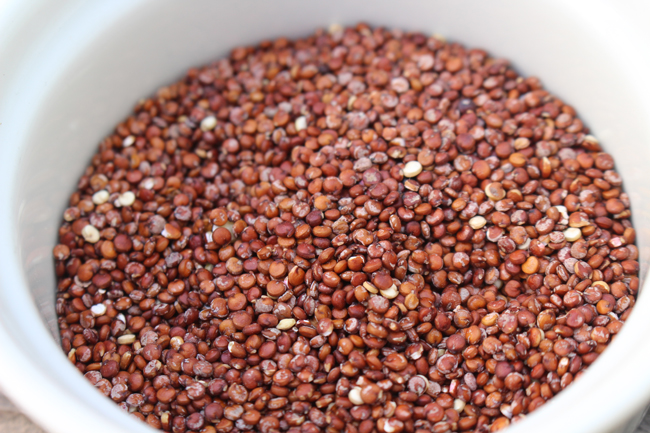
How Many Whole Grains Do You Know Besides Brown Rice?
Eating whole grains are good for us.
What are whole grains? How many whole grains do you know besides brown rice?
Brown rice and quinoa are most popular ones right now in the America.
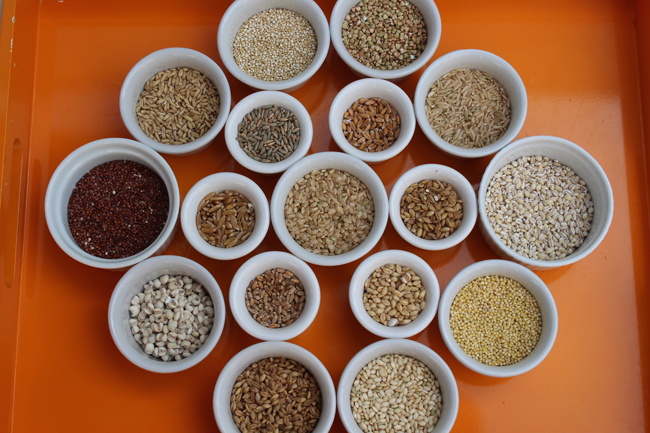
How many whole grains can you identify?
Eating whole grains have many benefits – “getting fiber, a healthy plant-based protein, vitamins, minerals, and a variety of phytochemicals that will improve your health.”
It is simple way to cook whole grains, but they all have different energy effects and some are different way to cook.
Usually after rinse them with spring water three times or more, you soak most of them 4~6 hours or over night. Sometimes you roasted to make more fire energy for the person who has too cold energy deficiency to bring Ki/Chi energy up.
My recent cooking class I show how to cook five different kinds of whole grains. There are many benefits and different way to cook so it is important to learn how to cook properly each whole grains.
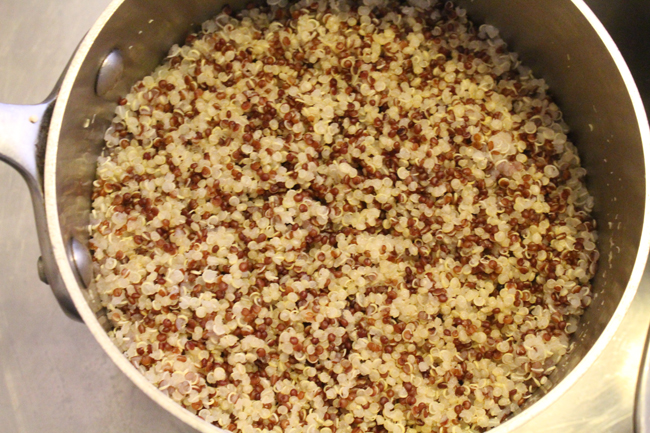
Red and Yellow quinoa cooked togethe
Red and Yellow Quinoa
1 cup red quinoa
1 cup yellow quinoa
3 cups spring water
2 pinch sea salt
bring up to boil and simmer for 15~20 minutes.
Move it on a trivet after turning off the heat, but keep the lid for another 5 ~ 10minutes.
Recently many people might heard “Quinoa” is good, but do they really know why?
Well, the first Quinoa is one of whole grains means complex carbohydrate. Complex and simple carbohydrate are very different.
Quinoa often referred to as the super grain and high in fiber and high-quality protein. In fact, it contains more protein than any other grain while also packing in iron and potassium. One half cup of quinoa has 14 grams of protein and 6 grams of fiber.
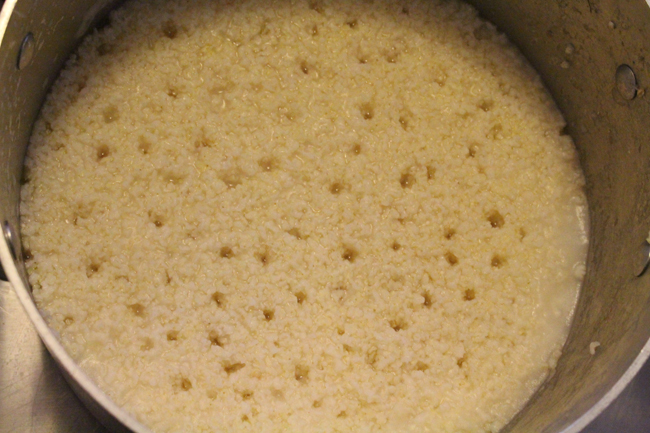
Creamy Millet
Creamy Millet
1 cup millet
4 cups spring water
one pinch sea salt
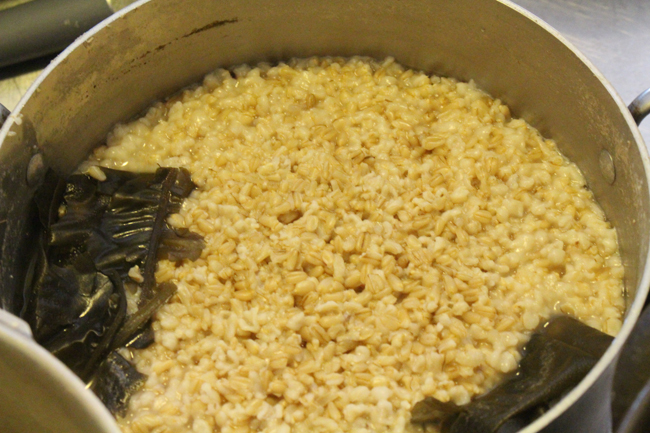
Whole Oats
Whole Oats
2 cups whole oats
6 cups spring water
2″ kombu
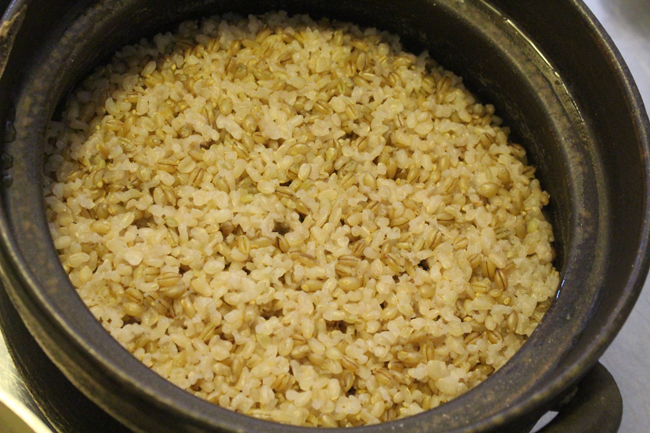
Whole Barley and Brown Rice
Whole Barley and Brown Rice
2 cups brown rice
2/3 cup whole barley
2 pinches sea salt
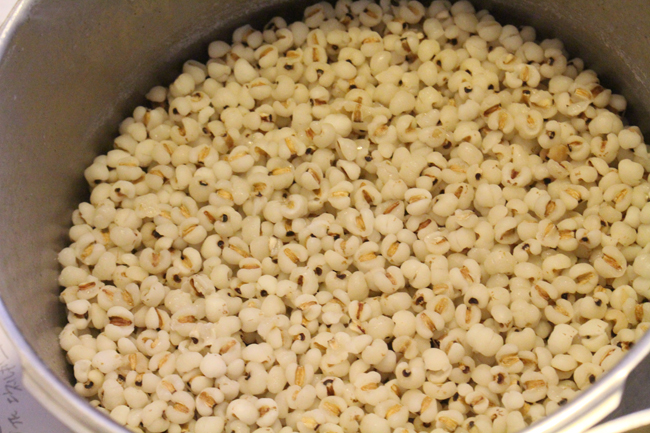
Hatomugi
Hatomugi
2 cups hatomugi
4 cups spring water
2 pinches sea salt
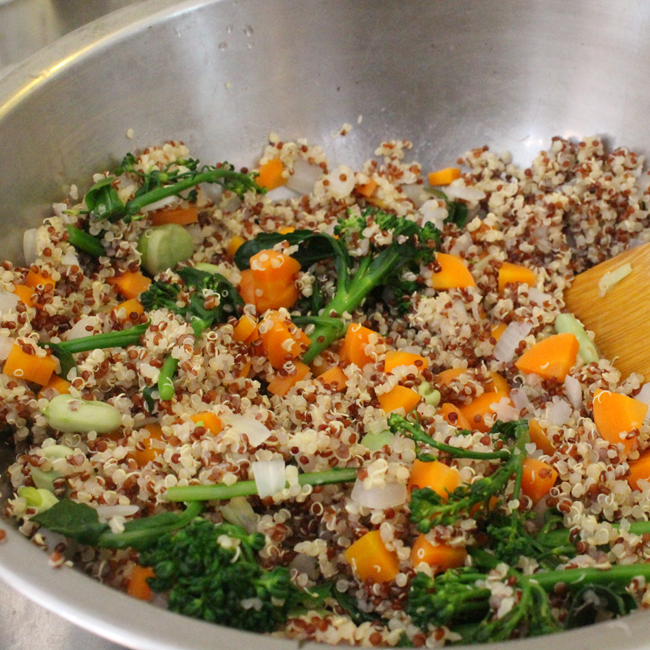
Quinoa Salad
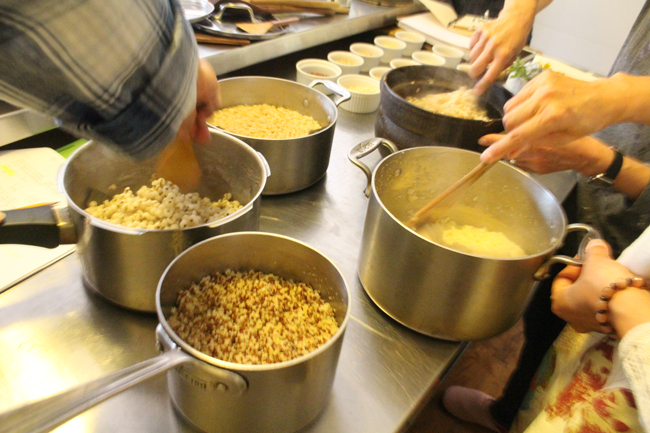
How to mixed whole grains
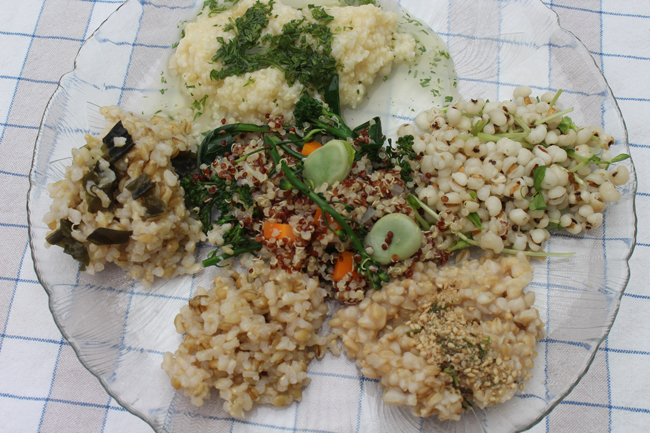
Five Whole Grains Plate

Making goals each year!
Every year I have been making a list my goals for a while.
I realized that I am a big achiever and have expected too much from myself sometimes when I turned 60 years old last year.
I felt that it was time for me to transform to connect inner happiness more than ever. No matter how much you made money or you are success in business it does not matter to me if I am not connected to myself and be with my love ones so I made this year priority goal to be “enjoy my life with my family and spending more time with them”. My family who I live with has been my husband, Eric, six dogs and two cats.
It was my husband, Eric and Kula (eldest dog)’s birthday last weekend. Eric got his new Naish paddle surf board.

Eric with his new Naish
Kula is now 13 so it is very special to us since her mother passed age of 12 and her most of sibling left much younger age so we wanted to give her special gifts.

Kula with her new bed
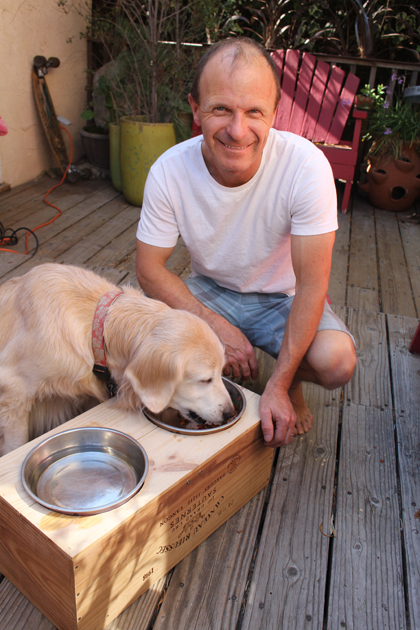
Kula with her new food bowl holder

Eric with his wave
She got her new bed, and her food bowl holder made by Eric and took her to her and our favorite place…the beach.

Eric, Oro and Kula
Besides spending time with my family I also wanted to try a paddle board myself. Since Eric has started it a few years ago I really wanted to try, but because of my both legs were broken from car crash in 2001 and doctor told me I may never walk. It took a long time…for me to be able to live life functionally. One year bed ridden, four years a wheel chair life with many years of physical therapy, energy work and eating healing macrobiotic food. I started to walk with a cane and continued my goal of making myself strong and did my best whatever I can to bring my motivation up.
Yoga, meditation, Bach Flower Remedy, Massage, Reiki, aromatherapy, 12 step program and more. I am so happy that I did not give up.

My first paddle board with Lumi
I thought giving my health and happiness is the best gifts to give to Eric. I truly appreciate Eric and my furry family here with me.
Another goal is visiting my sister, brother and niece who are all in Japan every year if I can so I visited them last year and my niece came here this year.

Eric & Lumi
Making achievement to focus a little things like spending time with family is happiest thing that I have experience so I am going to continue my best!

Kula’s 13th birthday
Love, Sanae
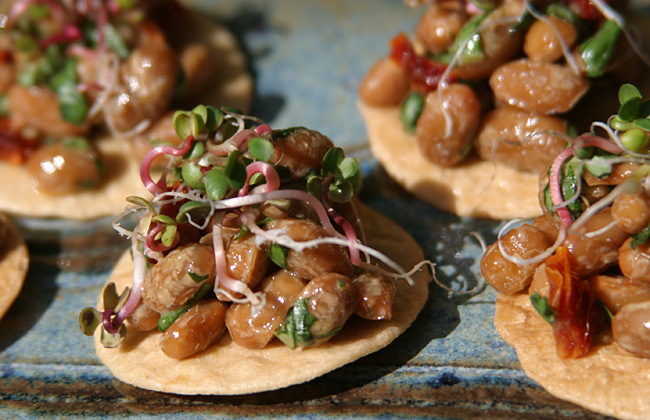
Natto Canapé
Natto is fermented soybeans that has been recognized as one of Japan’s most unique traditional health foods. Highly nutritious and rich in protein. One of best good bacteria foods for your stomach and intestine and many benefits so hear the list of benefits:
It moves blood circulation, which is great for those who have cold hands and feet due to poor blood circulation. Natto is also spleen supportive and digestive supportive. Natto’s unique culture also boosts the immune system.
1. Benefit of Natto
1) It moves blood circulation, which is great for those who have cold hands and feet due to poor blood circulation.
2) Natto is also spleen supportive and digestive supportive.
3) Natto’s unique culture also boosts the immune system.
4) Scientific research has revealed such a rich palette of health benefits, that many Westerners have adapted their palate to include this unusual food that is naturally rich in vitamin K2.
5) Protection from Alzheimers by removing plaque from the brain.
6) Prevention and reversal of arterial sclerosis and hypertension.
7) Anti-inflammatory properties promote joint health and reduce arthritic pain (also osteoporosis risk by K2)
8) Dissolves blood clots, offering protection from strokes (many people take aspirin for cardiovascular protection, but natto does this without the side effects of aspirin.)
9) Reduces bone loss, particularly in post-menopausal and older women.
10) Promotes healthy skin.
It has a powerful smell like cheese, strong flavor, and slimy texture so it is not easy to eat unless you get to use to eat it so preparation is important. Many people try Natto because it is healthy, but because of the strong smell and slimy texture they never enjoy to eat.
If you want to learn how to prepare to eat Natto deliciously and also learn how to make homemade Natto, please contact me sanaeshealing@gmail.com so I can let you know when I offer next Natto making and preparation class.
Here is one of my Natto preparation recipes “Natto Canapé” for Natto eating beginners so you can enjoy.
2. Recipe
Natto Canapé (fomented soy beans)
MAKES 4 SERVINGS
1 sun dried tomato (0.5 oz)
two leaves basil (5 leaves)
3 oz Natto (organic none GMO homemade is better)
tamari -soy sauce with no wheat or shoyu-soy sauce (option)
olive oil (option)
rice crackers
sprout
1. Soak sun dried tomato to be soft, drain the water and sliced very thin.
2. Chop basil leaves.
3. Mix sliced sun dried tomato and chopped basil into Natto in a bowl.
4. Add tamari or shoyu and/or olive oil.
5. #4 mix to place on a rice crackers.
6. Add sprout on the top as garnish/decoration.
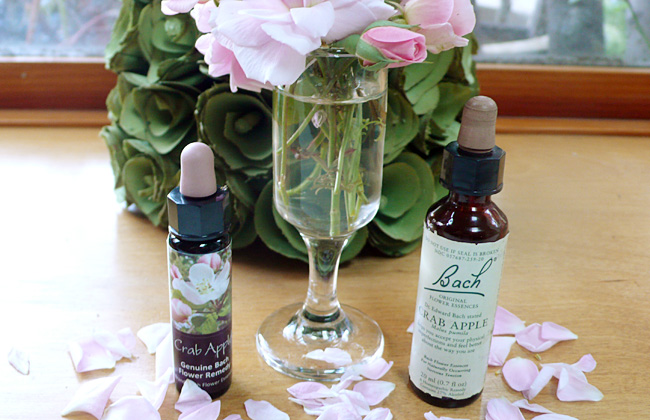
Bach Flower Remedy for Pollen Allergy
Surprisingly, many people are not aware of how much our mental and emotional state affects our physical health, and also how sensitive we are to the environment, which can cause many of our health issues, including allergies.
Allergies are an uncomfortable predicament that comes with a variety of bothersome symptoms that pop up or worsens for many people during the early Spring and can last for months. After our bodies have been exposed too much to pollen, animal hair, dust or chemicals etc., we become sensitized, and cannot tolerate that substance anymore. Dietary factors can cause reactions to allergens also. It is a disorder of the immune system that causes symptoms such as sneezing, itchy and watery eyes, and a runny nose. In some cases, these reactions can be very strong and cause severe, even life-threatening, conditions. Allergies are one of the most common afflictions that have people seeking alternative medicine and holistic care these days.
Bach Flowers are an array of 38 self-healing Flower Essence Remedies developed by Dr. Edward Bach in the U.K. in the 1930’s. Flower Essences are very safe energetic remedies that bring harmony to our mental and emotions and encourage positive thinking, allowing us to be more joyful, calm, patient, focused, balanced, accepting, and more.
Use a single Bach Flower remedy or a blend, as directed, to encourage mind-body healing and wellness for optimal health. Bach Flowers are a wonderful, natural complement to any health plan or healing journey and can be used alongside any other remedy, including pharmaceuticals.
Here are the Bach Flowers that are recommended for allergies:
Beech: commonly used for intolerance. In this case, the allergy sufferer is experiencing intolerance to something in the environment that has invaded their space or body, like pollen, grass, and other organic matter. You might not believe it, but our attitude can affect us physically. Beech helps us tune into acceptance and tolerance. When the mind and soul are in an accepting mood, it is much easier for the body to follow suit. Definitely one worth trying when itchy eyes or sneezing is out of control!
Crab Apple: generally used when there is something to get rid of, like negative thoughts, feelings, and beliefs. Also useful when there is literally something in the body that we need to get rid of, like allergens. These allergens may enter the body through our interaction with the environment; just opening a window can set off allergic reactions for some people. The annoying allergens can also gain access through the food we eat. Sometimes chronic infections play a role in allergies. They can poison the body and make it overly sensitive. Crab Apple helps with release on all levels. A common recommendation for allergy sufferers is to detoxify the body, basically help out the body’s natural process of release. Crab Apple is one of the best remedies for physical release and my favorite for an energetic cleanse and the most important detoxifying essence.
Walnut: for over-sensitivity to change. The transition from winter to spring is a big change and some of us really feel it. The shift in seasons can affect our sleep, mood, appetite, and energy levels. Walnut can also be used for over-sensitivity in general. The more sensitive you are to an allergen, the harsher your reaction will be. Walnut helps the mind and body adapt and encourages an attitude that is open to change, helping us deal with all types of transitions.
Any other Bach Flower: depending on your emotions, mental state, personality and the attitude you have toward your suffering, you may find a variety of the other Bach Flowers helpful during allergy season. Here is a quick description of a few:
– Holly for anger. Are you mad at the world or your body for doing this to you? Are you jealous of everyone who is not suffering? Do your symptoms make you uptight and grouchy and everyone else knows it? Use Holly to tune into pure love and relaxed feelings. Holly also helps in cases of strong immune reactions. This can be used, for example, in severe fits of sneezing, clear cases of irritation, or allergic shock.
– Mimulus for fears we can name. Do you fear allergic reactions? Are you afraid to go outside or play in nature? Are you afraid to go to a certain place because your reaction will make you look silly or feel uncomfortable? Mimulus gives us courage to face our fears and be ourselves. You are not your disease.
– Olive to awaken the body’s healing potential. Are you exhausted by the battle against your allergy symptoms? Olive is a great remedy when lacking physical energy, especially after a long struggle. Olive brings the spark back to your soul.
– RESCUE REMEDY a popular combination of Cherry Plum, Clematis, Impatiens, Rock Rose, and Star of Bethlehem. An excellent go-to remedy for any occasion.
I believe that much of our chronic problems are stress related; and most stress can be tied into an emotion, such as fear, anxiety, or hopelessness. Over time you can see how these emotions could lead to physical distress. You might say then that these remedies are designed to get at the root of the problem.
You can use a remedy by itself or combine some of them. Look for Bach Flowers at your local natural health store or order them online. You can take 2 drops of each remedy at least 4 times a day. If you want to know how to make your own personal combination of remedies, I am available for counseling as a Bach Flower Registered Practitioner. Choosing the right remedy and how to take the right quantity are key to successful Bach Flower remedy. FOR More information, please email me sanaehealing@gmail.
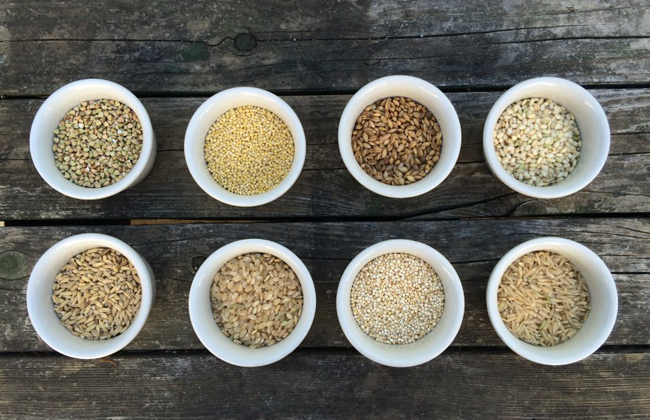
Macrobiotic Plant Based Vegan Cooking Class: Traditional Brown Rice Cooking without a Rice Cooker
Since I am from Japan it is a joy when I get to teach class in my native language, which is not often here in the United States.
When January 2016 arrived one I made one of my New Year resolutions to teach my macrobiotic principle cooking class series in Japanese once again. The last time I offered this series in Japanese was three years ago. After that I only taught a single Japanese class here and there, so this time I committed to teach one every month. Students will benefit by learning macrobiotic cooking from a more complete, progressive program of courses. I am grateful that I have realized my goal and started the first class last week.
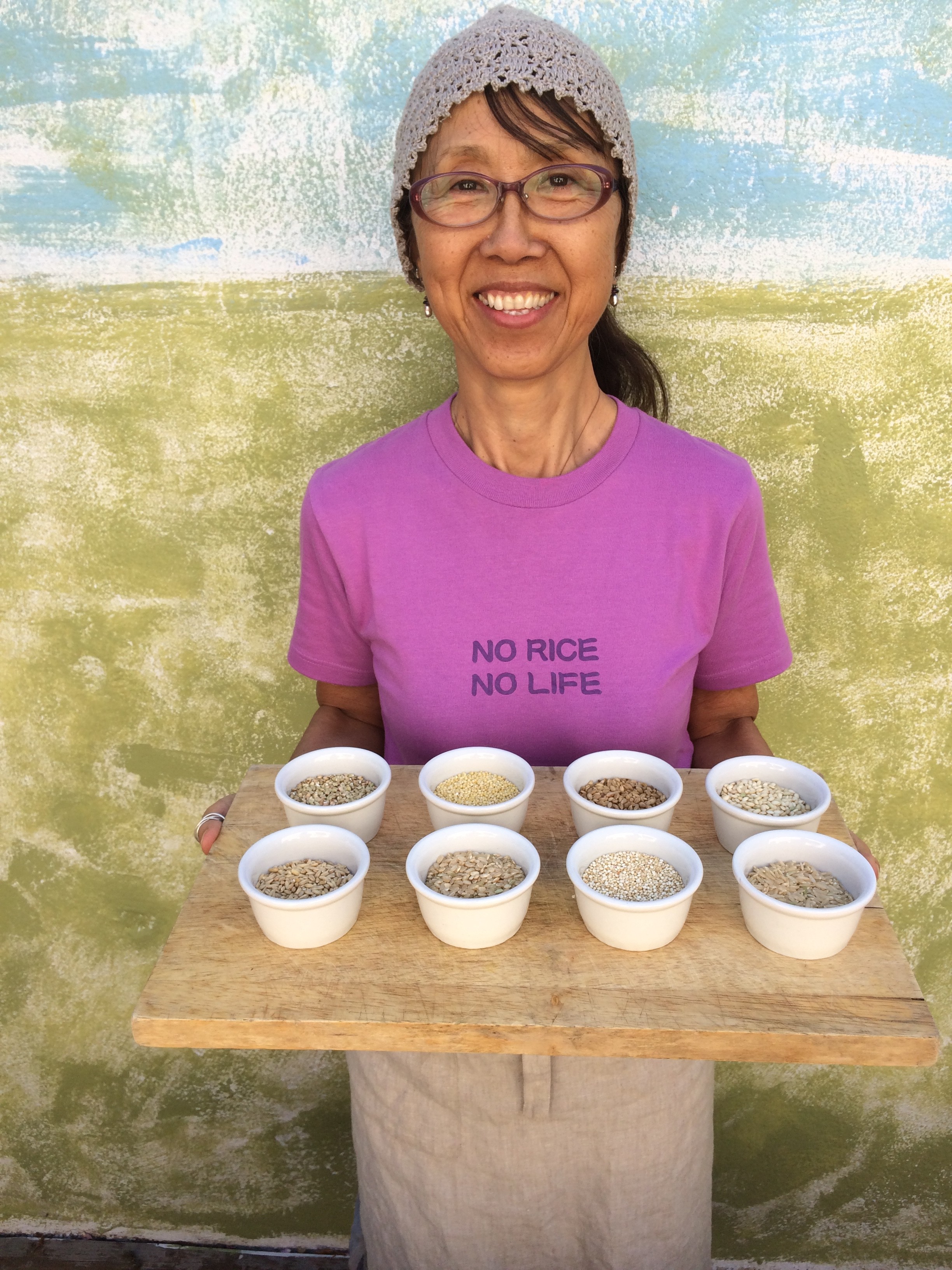
“No Rice No Life” T-shit was a perfect for this class. Can you identify these whole grains?
I taught Whole Grain part 1 cooking class last week. Introduced eight different whole grains: 1) short grain brown rice, 2) long grain brown rice, 3) sweet brown rice, 4) whole oats, 5) whole barley, 6) millet, 7) quinoa, and 8) buckwheat first (this was fun for students to know there are many whole grains and to identify whole grains since most of us do not know many whole grains are available for us to cook. I showed how to prepare and cook brown rice the traditional way (macrobiotic way), without a rice cooker. All the Japanese students know how to make white rice in the rice cooker and some know how to make brown rice, since rice cooker companies have developed the rice cooker for cooking brown rice. Japanese people usually never make rice without a rice cooker, and I was one of them until 1993. It means departing from a convenient routine, which is not easy for most of us. Japanese students are very polite, and they do not say much in class; I guess they do not want to interrupt the teacher, but after class some of them ask me questions or tell me their thoughts. During this class only one student who had lived in the U.S. for a long time spoke up. Most of them told me after class that they were a little concerned that brown rice would not be as tasty if they did not use a rice cooker, but they were surprised when all the three different kinds of preparation of brown rice came out so delicious, even better than when cooked in a rice cooker. In fact, they found the rice that got burned at the bottom to be tasty as well. That’s right, after having taught cooking for over 20 years, I still burn the rice, and I want my students to see me as I am – not perfect. I want them to understand that sometimes we burn the rice, and it is alright as long as we know why it happened. It is important to accept it, since making mistakes is part of life, right? We just need to know what happened and do our best to not repeat the mistake as much as we can (but we also accept that as humans we make the same mistakes over and over until we really learn).
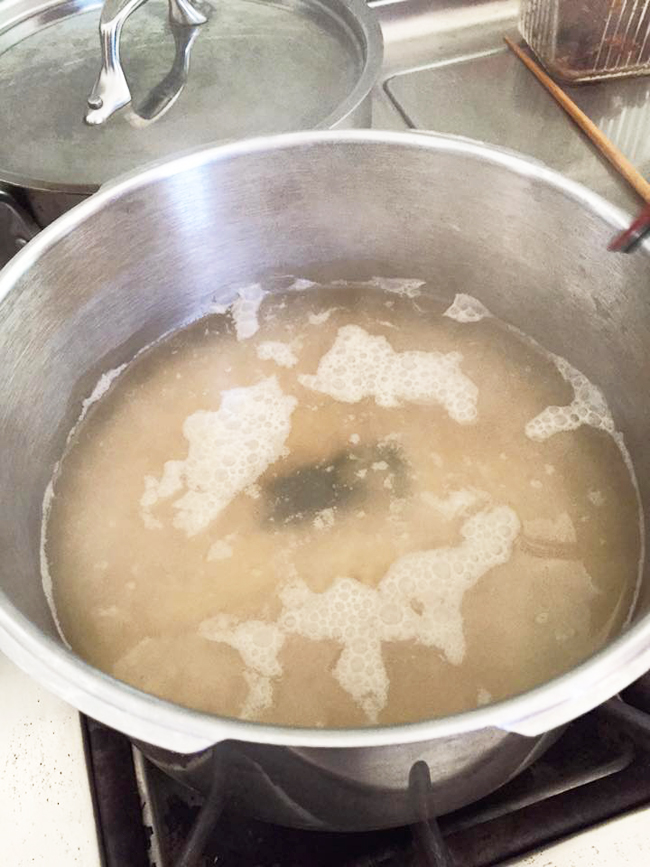
Brown rice with kombu sea vegetable
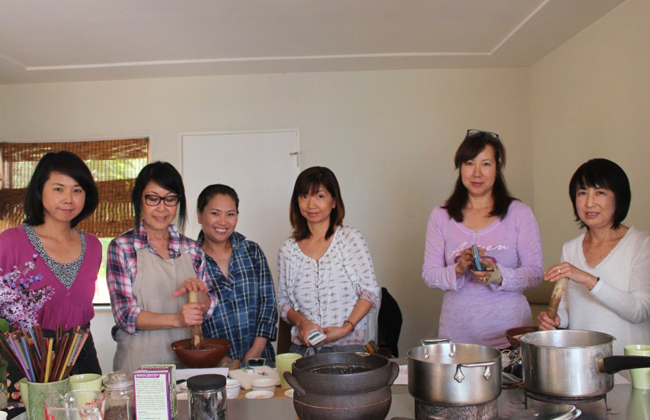
In this class I showed three different ways to cook brown rice:
First, all the brown rice are washed and soaked over night.
1. in a stainless steel pot, 2 cups of brown rice with 4 cups water and add a pinch of sea salt when it start to boil and simmer for 45 minutes. You don’t have to mention how much rice & water to add?
2. in a ceramic pot, called “Nabe” in Japanese, 2 cups of brown rice with 4 cups water and add a stamp sized piece of kombu sea vegetable when it start boil and simmer for 45 minutes.
3. in a pressure cooker, 2 cups of brown rice with 4 cups water add a umeboshi plum (Japanese traditional pickled ume plum, which is very high in alkaline (organic California aged umeboshi plums can be purchase at Seed Kitchen) when it start to boil and simmer for 45 minutes.
Since I had not used the pressure cooker for a while, the pressure did not go up correctly, and I was also talking to students when it was time to remove it from the stove, so the rice cooked too long, burned the bottom slightly. I quickly removed it from the stove when I realized that I was talking instead of watching the pot, so I kindly sent the good wish to the rice and said “Sorry to have missed your perfect timing, but I am sure you are going to be tasty!”
I added quickly blanched stems of kale to the burned rice to dress it up with green polka dots, so it looked and tasted better.
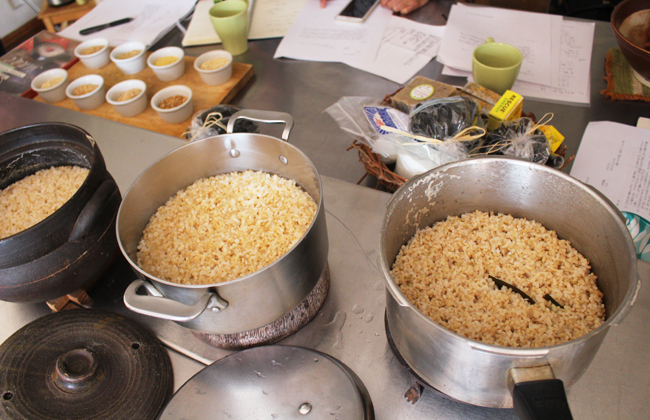
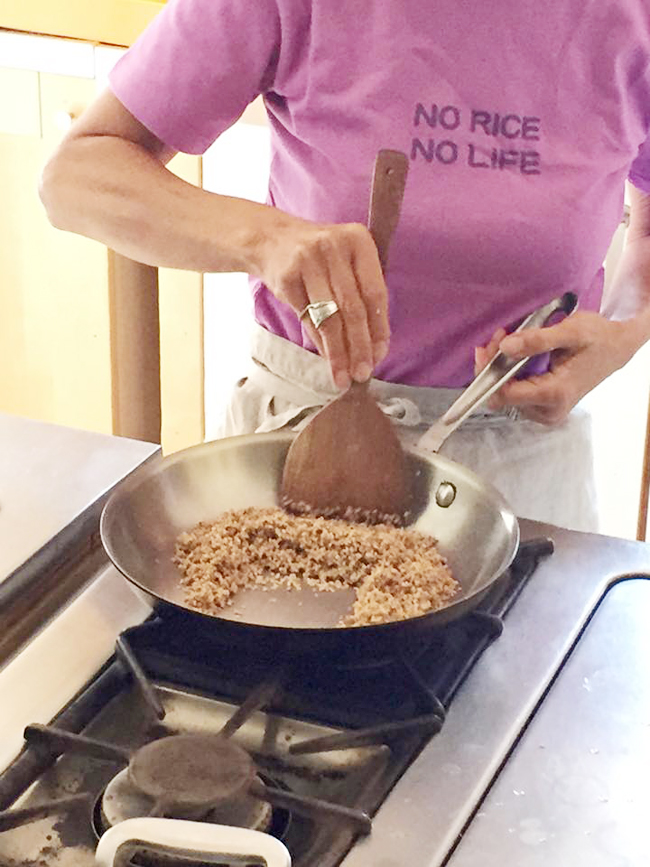
Roasting sesame seed after you rinsed sesame seed with water.
I also taught how to make gomashio (sesame salt which is usually recommended to eat with grains) condiment and quick water sautéed onion, carrot and kale.
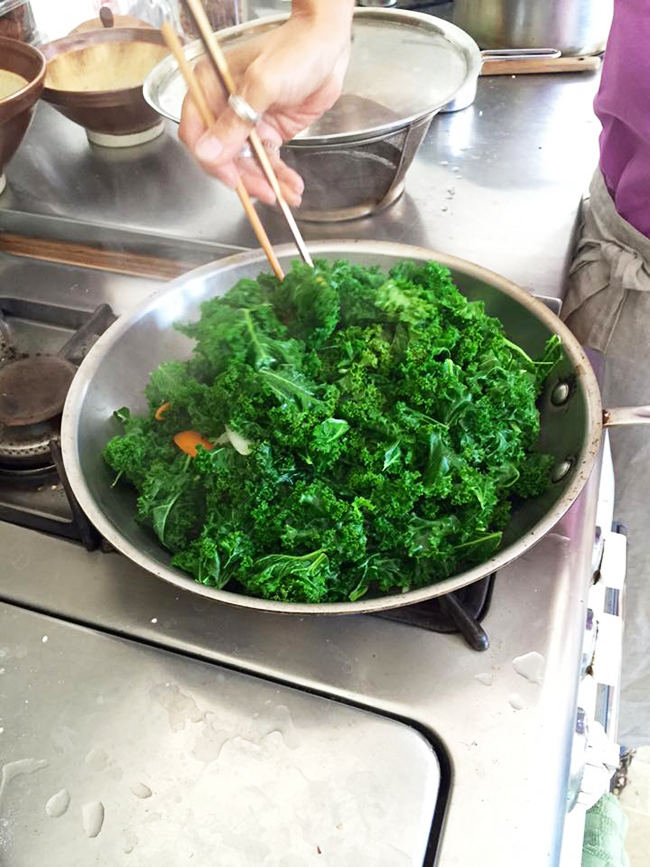
Water sautéed kale.
There was no time to teach how to make the dressing so I served fresh tahini miso dressing from Seed Kitchen (my husband Eric Lechasseur and my restaurant in Venice, California) which was so tasty some of the students were pouring it over the brown rice. Everyone wanted to learn how to make this dressing in the next class.
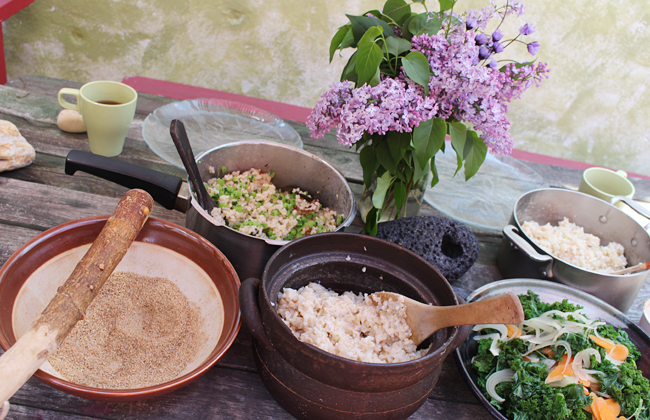
The food was all ready!
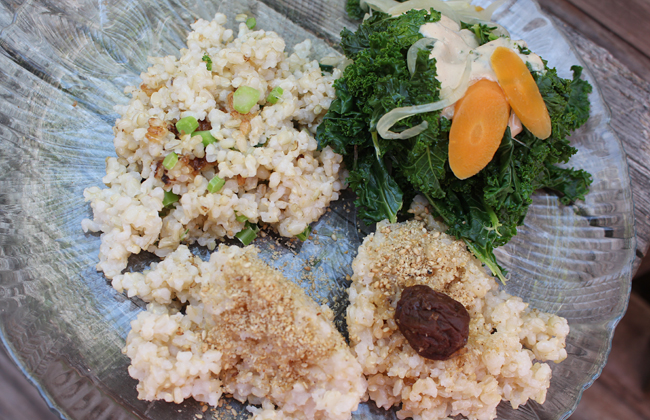
Simple and beautiful delicious three different kinds brown rice with vegetables.
We had a delicious lunch together outside on the picnic table under the California sunshine.
We all look forward to meeting again at the next class, Whole Grains part 2.
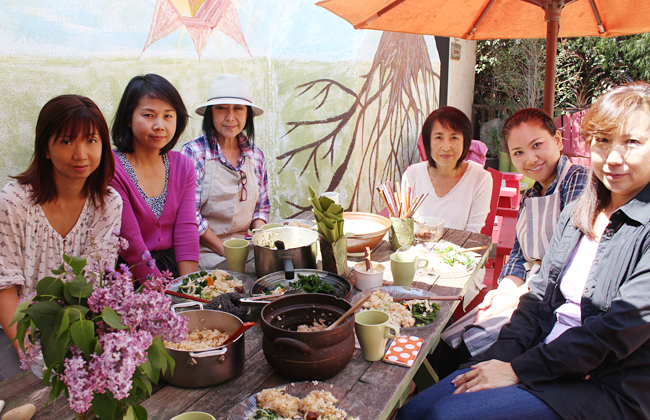
Love, Sanae❤️
These below questions are from one of students who took the class. I want to share them for other Japanese students to see and learn from them.
ビーガン・マクロビオティック基礎シリーズクラス第1回:
炊飯器を使わないで伝統的な玄米炊き方3種類。
下記にあるのはこのクラスを受講したYukoさんから来たメールにある質問ですが、
Yukoさんから承諾をもらってこのブログに載せました。
この答えがみなさんのお役に立てたら幸いです。
ー草千先生、
一昨日のクラス、ご指導頂きまして有難うございました。
素晴らしいメンバーの方々にも会えて感謝の気持ちでいっぱいです。
クラスの後にSeedに寄って主人と美味しいクッキーと昆布とお塩も購入させていただきました。
購入したお塩ですがお塩は常温保管でよろしいですよね?
入れ物(瀬戸物、ガラス、または木で作られた)に入れて常温で保存して下さい。
さて、課題の玄米炊きのおさらいとして早速、昨日ステンレスのお鍋で玄米を炊いてみました。
炊き上がり、表面は”カニの穴”も出来てふわっと炊けましたが鍋底は真っ黒に焦げてしまいました(涙)。。。
やはりフレイムディフレクターが無いせいでしょうか?
又は火が弱火よりちょっと強かったのかもしれません。
フレイムディフレクターがあれば焦げなかったでしょうが、きっと火の加減も少し強かったのかもしれませんから、次回は気をつけてみてやって下さい。
そして、ごま塩もホールフーズでオーガニックの生のゴマを見つけたので早速作りました。
やはりホカホカのご飯に香ばしいごま塩は最高ですね!レシピのとおりごま大さじ12に対しお塩を小さじ2杯で作ったのですが教室で試した時よりも塩辛い感じがしました。
お教室の時は少なめでしたか?
レシピは、スタンダードなごま塩の作り方の量になっていますが、クラスでは、感覚的に少し塩を少なめに使いました。
レシピは参考に使って自分の感覚や体調によって変えていくことが大切です。
お塩を煎ってすり鉢にかけてごまを煎ってすり鉢にかけてじーっくりと美味しくなるようにごま塩を擦っている時は私にとって良いメディテーションだなぁと思いました(笑)。
そうですね、メディテーションと言って正解ですね。私もごま塩を作る時にいつもそう感じていますよ。
この次は圧力鍋と土鍋で試してみます。尚、お鍋ですが
オススメの圧力鍋のメーカーなどございますか?
圧力鍋はいろんな種類があって好みだと思いますが、私は、KUHN RIKONを使っています。
土鍋は先生のような深いご飯炊き用が良いのですよね?
鍋は通常の鍋でも美味しく炊けますので、もしもっていたらそれをまず使ってみて下さい。
私が使っているご飯炊き用の鍋を見つけたら購入してみて下さい。
いくつかの質問、アドバイスいただけたら幸いです。
よろしくお願いいたします。
P.S. マクロビにコーヒーは厳禁だと思います。がどうしても朝のコーヒーがやめられません。
先生の本に色々なレメディドリンクのレシピがありますが
私におすすめのドリンクはありますか?
マクロビをしている人でコーヒーを飲んでいる人もいますが、
お茶やコーヒーに含まれるカフェインは、カルシウムの排出を進ませますので、
やはり病気治しをする時はコーヒー、お茶を飲むのをやめるべきだと私は思います。
やめる為のレメディーは、実際にはありませんが、甘い野菜のレメディーは、コーヒーを飲んで疲れ気味な膵臓を癒してくれます。(Love, Sanaeの本のページ164のSweet vegetable Drink参照)
やめ方は少しずつ飲むのをやめる方法と一度の飲むのをやめる方法のふたつですが、どちらにするかは自分の性格とやめた時の精神的また感情的状態を把握して心の準備が必要です。
少しずつやめる場合はコーヒーをお茶(緑茶)に変えてから少しづつ減らしていくと成功率が高いと他の生徒さんやクライエントさんから聞きました。
コーヒーを飲むのをやめた時どんな禁断症状があるか、それとコーヒーを飲むのをやめるときに注意することを次回のクラスで少しお話しますね。
愛をこめて、草千❤️
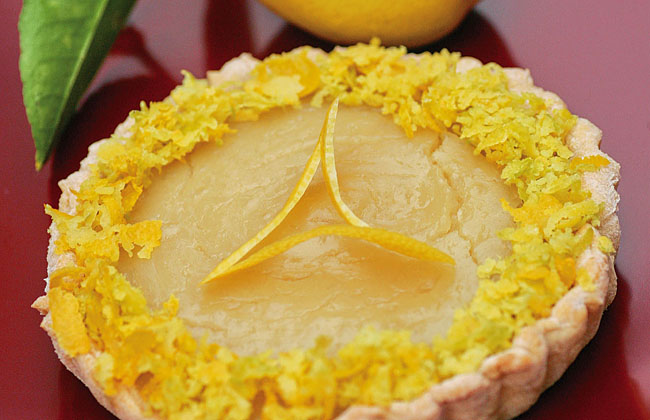
Amazake Meyer Lemon Pie – Plant Based Vegan Macrobiotic Delicious Dessert
When I moved to Santa Monica I decided to grow my own lemon tree, so I searched for the kind I would like most. It was not difficult for me to fall in love with the Meyer lemon, which is light and refreshing, sweet, and soft-skinned. I asked Eric to make a lemon pie as soon as my tree produced lemons. It was so delicious, and we could not keep it a secret, so Eric put the recipe in his first cookbook, “Love, Eric“, delicious vegan macrobiotic desserts. Each spring when my Meyer lemon tree produces fruit we make this pie, so I want to share the recipe with you so you can enjoy it like we do.
MAKES 1 PIE (9 inch pan)
For the pie crust:
1 cup spelt flour
3⁄4 cup unbleached flour
1⁄4 teaspoon sea salt
1⁄3 cup maple sugar
1⁄3 cup safflower oil
1⁄4 cup water
For the lemon filling:
1 cup plain amazake
1 1⁄2 cups lemon juice
1⁄4 cup rice syrup
1⁄4 cup maple syrup
1 teaspoon vanilla extract zest of
1 lemon
2 1⁄2 tablespoons agar flakes
4 tablespoons arrowroot
1⁄4 cup apple juice
extra lemon zest for garnish
To make the pie crust:
1. Preheat the oven to 350°F.
2. Combine the dry ingredients in a large bowl.
3. Add the oil and water, and knead quickly to form a dough. Allow dough to sit for 15 minutes.
4. Using a rolling pin, roll the dough in to a circle to fit a 9-inch pie pan. (Dough thickness should not exceed 1⁄4-inch).
5. Gently line the pie pan with the dough and bake for 20 to 25 minutes. Remove from the oven and allow to cool.
To make the lemon filling:
1. Combine all the ingredients, except for the arrowroot and apple juice, in a saucepan. Bring to a simmer and cook for 8 minutes, whisking constantly.
2. In a small bowl,combine the arrowroot and the apple juice, then whisk into the lemon filling.
3. Continue cooking and whisking a few more minutes. Remove from flame and allow to cool slightly.
4. Pour the filling into the baked pie shell. Garnish with lemon zest around the edges and refrigerate until firm.
from “Love, Eric “Delicious Vegan Macrobiotic Desserts Cookbook
Enjoy!
Love,
Sanae
